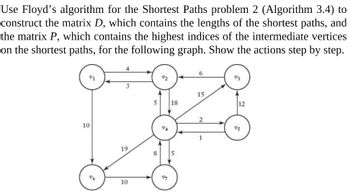Question

Transcribed Image Text:Use Floyd's algorithm for the Shortest Paths problem 2 (Algorithm 3.4) to
construct the matrix D, which contains the lengths of the shortest paths, and
the matrix P, which contains the highest indices of the intermediate vertices
on the shortest paths, for the following graph. Show the actions step by step.
10
4
3
19
10
5
VA
18
8 5
27
6
15
1
12
95
Expert Solution
This question has been solved!
Explore an expertly crafted, step-by-step solution for a thorough understanding of key concepts.
This is a popular solution
Trending nowThis is a popular solution!
Step by stepSolved in 3 steps with 3 images

Knowledge Booster
Similar questions
- 2. This question is about Dijkstra's algorithm. 2 B 3 A 8 D 4 14 1 F E 1 Using Dijkstra's algorithm to find the shortest path from A to all other vertices from the graph above. Illustrate all intermediate steps with table(s). а. b. Write down the shortest path from A to F. Explain how to obtain the shortest path from A to F using the result of (a).arrow_forwardPlease, I want a correct solution to all paragraphs. The solution must be in text format and not handwrittenarrow_forwardGiven the following adjacency matrix representation of a graph to answer the followed questions. 0 1 1 0 1 100 10 A.. B. I C. D.₁. 1000 1 0 0 1 0 0 1 0 1 1 is it directed graph or not and why? ] How many vertices are there in the graph? How many edges are there in the graph? reRepresent the graph using an adjacency list.arrow_forward
- Trace Floyd's algorithm for the all-pairs shortest path problem defined over a digraph with vertices V= {1, 2, 3, 4) and whose cost matrix is given below: 11 0482 081 2805 2630 201arrow_forwardI want to learn this. Please explain :)arrow_forwardPROBLEM 6 Part 1. Give the adjacency matrix for the graph G as pictured below: 3 Figure 2: A graph shows 6 vertices and 9 edges. The vertices are 1, 2, 3, 4, 5, and 6, represented by circles. The edges between the vertices are represented by arrous, as follows: 4 to 3; 3 to 2; 2 to 1; 1 to 6; 6 to 2; 3 to 4; 4 to 5; 5 to 6; and a self loop on verter 5.arrow_forward
- Consider the un-directed graph shown in the Fig. The values inside the node refer to the feature value of the node. The order of the nodes is A,B,C,D when following the matrix form in below questions.(You can use python or other languages to find the eigen values and other operationfor this question):1. For the given graph, write down the degree matrix, adjacency matrix, and Laplacian matrix representation.2.Find the eigenvalues and eigenvectors of the graph Laplacian matrix. Do you see any pattern pertaining to the signs of the eigenvalues (all positive or negative or no such pattern). Will it be same for all such graph Laplacianmatrices, and why?arrow_forwardAlgorithmarrow_forwardConsider the following graph and Dijkstra's algorithm to find the shortest paths from the vertex A. (See image attached) The distances / weights in the incident edges at the vertex F are given in the table: edge: (B, F) (C, F) (E, F)distance: 8 11 4.5 At the end of the algorithm, what is the value of the distance for the vertex F?arrow_forward
- 3. Find a shortest path from node A to node M in the graph with edge weights shown on the graph by Dijkstra's Shortest-Path Algorithm. A 5 3 B 6 1 3 6 2 D 3 2 F 5 2 E 2 3 H 4 3 2 3 4 K 5 Marrow_forwardA.) Running Dijkstra's algorithm with vertex A as the starting point, list the order in which the vertices would be marked. (Don't forget to include the starting vertex.) B.)What is the shortest distance discovered to vertex E? C.In the course of running Dijkstra's algorithm on the graph shown above, how many different (non-infinite) distances were found for vertex E?arrow_forwardPlease provide answer fast & It should be correct.arrow_forward
arrow_back_ios
SEE MORE QUESTIONS
arrow_forward_ios